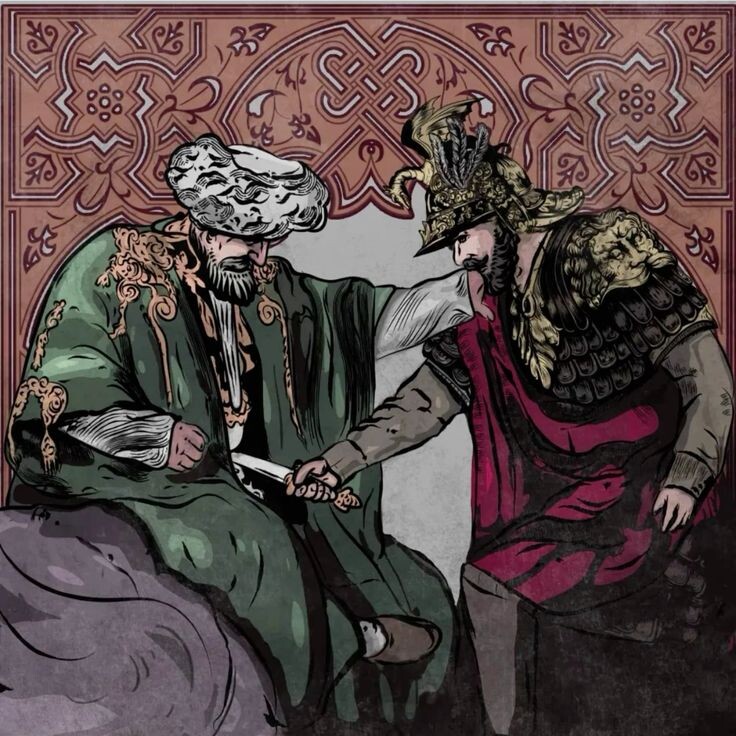A small Ottoman force first crossed into Europe in 1352, at the end of Bey Orhan’s reign. The Turks managed to capture an outpost, but had not yet begun any real conquests. Only Murad I, the first representative of the dynasty who called himself Sultan, was able to gain a foothold in the Christian territories. He began to annex Slavic and Byzantine lands, but soon suspended the onslaught, as he began to be squeezed by Anatolian Muslim principalities. It was not until the 1380s that a new campaign against the Balkan Christians was launched. But in the battle of Kosovo Field, Murad was killed — although it is still unknown exactly how.
Let’s tell the story of the first Ottoman sultan.
Murad was born around 1326. His father was Orhan-gazi, the second ruler of the Ottoman beylik (principality), which at first still paid tribute to the Mongols. His mother was a Greek woman named Nilufer, the first Christian to give birth to an Ottoman monarch.
Murad was the second son of his parents and at first was in the shadow of his older brother Suleiman, who commanded the very unit that began the European conquests. But after the death of his rival in 1359, he actually took over the power from his father, who was too old and saddened by the death of the heir. At that time the territory of the Ottoman state was about 95 thousand square kilometers, during the years of his reign Murad will increase it about five times.
He began with the conquest of the old Byzantine city of Adrianople, where in 378th year the Romans fought with the Goths. In 1362, Murad captured it and moved the capital of his growing empire there. A decade later, it had to repel a joint attack by Serbian principalities who hoped to drive out the Turks.
But then the grand vizier rebelled, his younger brothers refused to recognize his supreme suzerainty, and in Anatolia Murad was attacked by the Ottomans’ longtime enemy, the powerful Beylik Karaman. The Byzantines recaptured many fortresses captured by the Turks.

In a short time, Murad got rid of each of these problems. The Karamanids lost a decisive battle, the brothers lost their heads (for the first time in Ottoman history), and the vizier was defeated and exiled. The sultan returned to Europe to continue his conquests. In the 1360s and 1370s, all the Balkan states lost some of their territories and were forced to pay tribute, including the main powers in the region — Serbia, Bulgaria and Byzantium. This happened only twenty years after the Turks set foot on the European shores.
In 1373, a marvelous thing happened: both the Ottoman sultan and the Byzantine emperor were far from their capitals. Their sons agreed with each other and announced the removal of their fathers from power. But both monarchs took them prisoner when they returned home with their armies — each of the princes was blinded. However, Murad was not satiated by this, and in a moment of anger gave orders to send the rebel shehzadeh to heaven.
By the mid 1370s, the sultan repulsed a crusade and a joint attack by the orthodox states. He then returned to Edirne and spent the next five years without war, busy settling the vast state. He married his son Bayazid to the daughter of the ruler of the Beylik Hermiyan, who as a dowry gave the Ottomans several cities. And then Murad bought some territories from other Anatolian principalities. At this time, the level of his power became unprecedented, probably, it was then that he first called himself a sultan.
It was time to continue the conquests, and Murad appointed several commanders to the main directions, entrusting them with irregular cavalry akynji. Some of them were successful, but the main corps was defeated by the Serbs on retreat. Those created a large coalition, which was joined by both Ottoman vassals and the rulers of interested states in the Balkans.

And then the Sultan had to solve this issue on his own. In 1389 he left Edirne with 30 thousand troops, including the newly created Janissaries — however, at that time the number of the corps reached only 2 thousand foot soldiers. He was soon blocked at Kosovo Field, north of the city of Skopje. At that time it was the core of Serbian lands, and now here is the capital of Macedonia.
In a fierce battle, the Turks were victorious, but the Sultan himself was struck down by Serbian knight Milos Obilic. Although the circumstances of his death sources of different countries describe in their own way. Ottoman chroniclers wrote that Murad was stabbed when, after the battle was over, he was walking around the battlefield comforting his wounded soldiers. One added to the story by saying that the Serb approached by guile, saying he wanted to become a Muslim.
The Serbs wrote that the Sultan was in his tent and Obilic came there, asking for a meeting. The Moldavians do not give a specific name, but say that the deed was done by a certain Christian warrior, lying unconscious, who reacted to the Turkish words as Murad and his retinue passed by. The Venetians even claim that everything happened in battle, when a small detachment managed to break through the ranks of the Turks.

Either way, Murad was the first and only Ottoman sultan who did not die of his own accord, but fell in battle — although whether there was a battle, we do not know. His successor, Bayezid, first maintained the secrecy to put his rival brother to death. Although the Ottoman army was forced to retreat and the new sultan temporarily gave up his conquests, the Christian coalition soon disintegrated and most of the Serbian princes became loyal vassals of the Turks.
